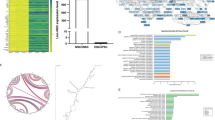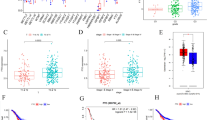Abstract
This study aimed to investigate the function of glioma stem cells (GSCs) and the role of PCAT1. This study dissociated the differences between GSCs and glioma cells in terms of apoptosis rate and γH2AX positive cells levels after radiation. Microarray was carried out to detect that expressed PCAT1, and it was testified by RT-qPCR. After transfection, GSCs were used to investigate the influence of PCAT1 on radiation sensitivity. Sphere-formation capability was first examined. Cell apoptosis rate after radiation of 0 Gy or 6 Gy was analyzed by flow cytometry, and the level of γH2AX positive cells after 6 Gy radiation were compared. CCK8 assay was used to investigate the cell proliferation and RT-qPCR was used to examine miR-129-5p and HMGB1 expression. GSCs exhibited great capability in sphere formation and lower expression in apoptosis and γH2AX positive cells rates after 6 Gy radiation. PCAT1 had higher expression in GSCs. PCAT1 knockdown restrained the sphere-formation ability, increased the apoptosis rate and DNA damage under the treatment of radiation. Moreover, knockdown of PCAT1 inhibited the cell proliferation. In addition, silencing PCAT1 could increase the expression of miR-129-5p and decrease the expression of HMGB1. PCAT1 was overexpressed in GSCs and played a facilitating role in radiation resistance.




Similar content being viewed by others
References
Ostrom QT, Gittleman H, Liao P, Vecchione-Koval T, Wolinsky Y, Kruchko C, Barnholtz-Sloan JS (2017) CBTRUS statistical report: primary brain and other central nervous system tumors diagnosed in the United States in 2010–2014. Neuro Oncol 19:v1–v88
Wen PY, Huse JT (2017) 2016 World Health Organization classification of central nervous system tumors. Continuum (Minneap Minn) 23:1531–1547
Komotar RJ, Otten ML, Moise G, Connolly ES Jr (2008) Radiotherapy plus concomitant and adjuvant temozolomide for glioblastoma—a critical review. Clin Med Oncol 2:421–422
Zhang D, Cao J, Zhong Q, Zeng L, Cai C, Lei L, Zhang W, Liu F (2017) Long noncoding RNA PCAT-1 promotes invasion and metastasis via the miR-129-5p-HMGB1 signaling pathway in hepatocellular carcinoma. Biomed Pharmacother 95:1187–1193
Liu Y, Shen Y, Sun T, Yang W (2017) Mechanisms regulating radiosensitivity of glioma stem cells. Neoplasma 64:655–665
Roccograndi L, Binder ZA, Zhang L, Aceto N, Zhang Z, Bentires-Alj M, Nakano I, Dahmane N, O’Rourke DM (2017) SHP2 regulates proliferation and tumorigenicity of glioma stem cells. J Neurooncol 135:487–496
Yang W, Yu H, Shen Y, Liu Y, Yang Z, Sun T (2016) MiR-146b-5p overexpression attenuates stemness and radioresistance of glioma stem cells by targeting HuR/lincRNA-p21/beta-catenin pathway. Oncotarget 7:41505–41526
Brodie S, Lee HK, Jiang W, Cazacu S, Xiang C, Poisson LM, Datta I, Kalkanis S, Ginsberg D, Brodie C (2017) The novel long non-coding RNA TALNEC2, regulates tumor cell growth and the stemness and radiation response of glioma stem cells. Oncotarget 8:31785–31801
Bao S, Wu Q, McLendon RE, Hao Y, Shi Q, Hjelmeland AB, Dewhirst MW, Bigner DD, Rich JN (2006) Glioma stem cells promote radioresistance by preferential activation of the DNA damage response. Nature 444:756–760
Liz J, Esteller M (2016) lncRNAs and microRNAs with a role in cancer development. Biochim Biophys Acta 1859:169–176
Wang J, Liu X, Wu H, Ni P, Gu Z, Qiao Y, Chen N, Sun F, Fan Q (2010) CREB up-regulates long non-coding RNA, HULC expression through interaction with microRNA-372 in liver cancer. Nucleic Acids Res 38:5366–5383
Gong W, Zheng J, Liu X, Ma J, Liu Y, Xue Y (2016) Knockdown of NEAT1 restrained the malignant progression of glioma stem cells by activating microRNA let-7e. Oncotarget 7:62208–62223
Kiang KM, Zhang XQ, Leung GK (2015) Long non-coding RNAs: the key players in glioma pathogenesis. Cancers (Basel) 7:1406–1424
Yan TH, Yang H, Jiang JH, Lu SW, Peng CX, Que HX, Lu WL, Mao JF (2015) Prognostic significance of long non-coding RNA PCAT-1 expression in human hepatocellular carcinoma. Int J Clin Exp Pathol 8:4126–4131
Ge X, Chen Y, Liao X, Liu D, Li F, Ruan H, Jia W (2013) Overexpression of long noncoding RNA PCAT-1 is a novel biomarker of poor prognosis in patients with colorectal cancer. Med Oncol 30:588
Shi WH, Wu QQ, Li SQ, Yang TX, Liu ZH, Tong YS, Tuo L, Wang S, Cao XF (2015) Upregulation of the long noncoding RNA PCAT-1 correlates with advanced clinical stage and poor prognosis in esophageal squamous carcinoma. Tumour Biol 36:2501–2507
Qiao L, Liu X, Tang Y, Zhao Z, Zhang J, Liu H (2018) Knockdown of long non-coding RNA prostate cancer-associated ncRNA transcript 1 inhibits multidrug resistance and c-Myc-dependent aggressiveness in colorectal cancer Caco-2 and HT-29 cells. Mol Cell Biochem 441:99–108
Balci T, Yilmaz Susluer S, Kayabasi C, Ozmen Yelken B, Biray Avci C, Gunduz C (2016) Analysis of dysregulated long non-coding RNA expressions in glioblastoma cells. Gene 590:120–122
Pang LY, Saunders L, Argyle DJ (2017) Epidermal growth factor receptor activity is elevated in glioma cancer stem cells and is required to maintain chemotherapy and radiation resistance. Oncotarget 8:72494–72512
Eriksson D, Stigbrand T (2010) Radiation-induced cell death mechanisms. Tumour Biol 31:363–372
Liu M, Xu Z, Du Z, Wu B, Jin T, Xu K, Xu L, Li E, Xu H (2017) The identification of key genes and pathways in glioma by bioinformatics analysis. J Immunol Res 2017:1278081
Delaney G, Jacob S, Featherstone C, Barton M (2005) The role of radiotherapy in cancer treatment: estimating optimal utilization from a review of evidence-based clinical guidelines. Cancer 104:1129–1137
Elmore S (2007) Apoptosis: a review of programmed cell death. Toxicol Pathol 35:495–516
Ivashkevich A, Redon CE, Nakamura AJ, Martin RF, Martin OA (2012) Use of the gamma-H2AX assay to monitor DNA damage and repair in translational cancer research. Cancer Lett 327:123–133
Piccirillo SG, Binda E, Fiocco R, Vescovi AL, Shah K (2009) Brain cancer stem cells. J Mol Med (Berl) 87:1087–1095
Li P, Du CR, Xu WC, Shi ZL, Zhang Q, Li ZB, Fu S (2013) Correlation of dynamic changes in gamma-H2AX expression in peripheral blood lymphocytes from head and neck cancer patients with radiation-induced oral mucositis. Radiat Oncol 8:155
Bi M, Yu H, Huang B, Tang C (2017) Long non-coding RNA PCAT-1 over-expression promotes proliferation and metastasis in gastric cancer cells through regulating CDKN1A. Gene 626:337–343
Prensner JR, Iyer MK, Balbin OA, Dhanasekaran SM, Cao Q, Brenner JC, Laxman B, Asangani IA, Grasso CS, Kominsky HD, Cao X, Jing X, Wang X, Siddiqui J, Wei JT, Robinson D, Iyer HK, Palanisamy N, Maher CA, Chinnaiyan AM (2011) Transcriptome sequencing across a prostate cancer cohort identifies PCAT-1, an unannotated lincRNA implicated in disease progression. Nat Biotechnol 29:742–749
Fang K, Liu P, Dong S, Guo Y, Cui X, Zhu X, Li X, Jiang L, Liu T, Wu Y (2016) Magnetofection based on superparamagnetic iron oxide nanoparticle-mediated low lncRNA HOTAIR expression decreases the proliferation and invasion of glioma stem cells. Int J Oncol 49:509–518
Feng S, Yao J, Chen Y, Geng P, Zhang H, Ma X, Zhao J, Yu X (2015) Expression and functional role of reprogramming-related long noncoding RNA (lincRNA-ROR) in glioma. J Mol Neurosci 56:623–630
Yao Y, Ma J, Xue Y, Wang P, Li Z, Liu J, Chen L, Xi Z, Teng H, Wang Z, Li Z, Liu Y (2015) Knockdown of long non-coding RNA XIST exerts tumor-suppressive functions in human glioblastoma stem cells by up-regulating miR-152. Cancer Lett 359:75–86
Funding
This study was supported by Heilongjiang Province Health and Family Planning Commission Research Project (no. 2016-129); Harbin Science and Technology Talent Innovation Fund Project (no. 2016RAQXJ173).
Author information
Authors and Affiliations
Corresponding authors
Ethics declarations
Conflict of interest
The authors have no conflicts of interest to declare.
Rights and permissions
About this article
Cite this article
Zhang, P., Liu, Y., Fu, C. et al. Knockdown of long non-coding RNA PCAT1 in glioma stem cells promotes radiation sensitivity. Med Mol Morphol 52, 114–122 (2019). https://doi.org/10.1007/s00795-018-0209-8
Received:
Accepted:
Published:
Issue Date:
DOI: https://doi.org/10.1007/s00795-018-0209-8




